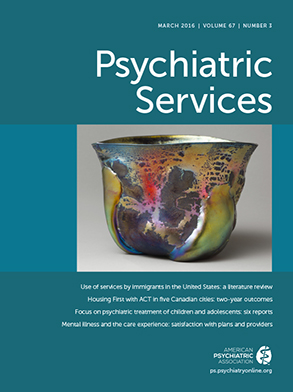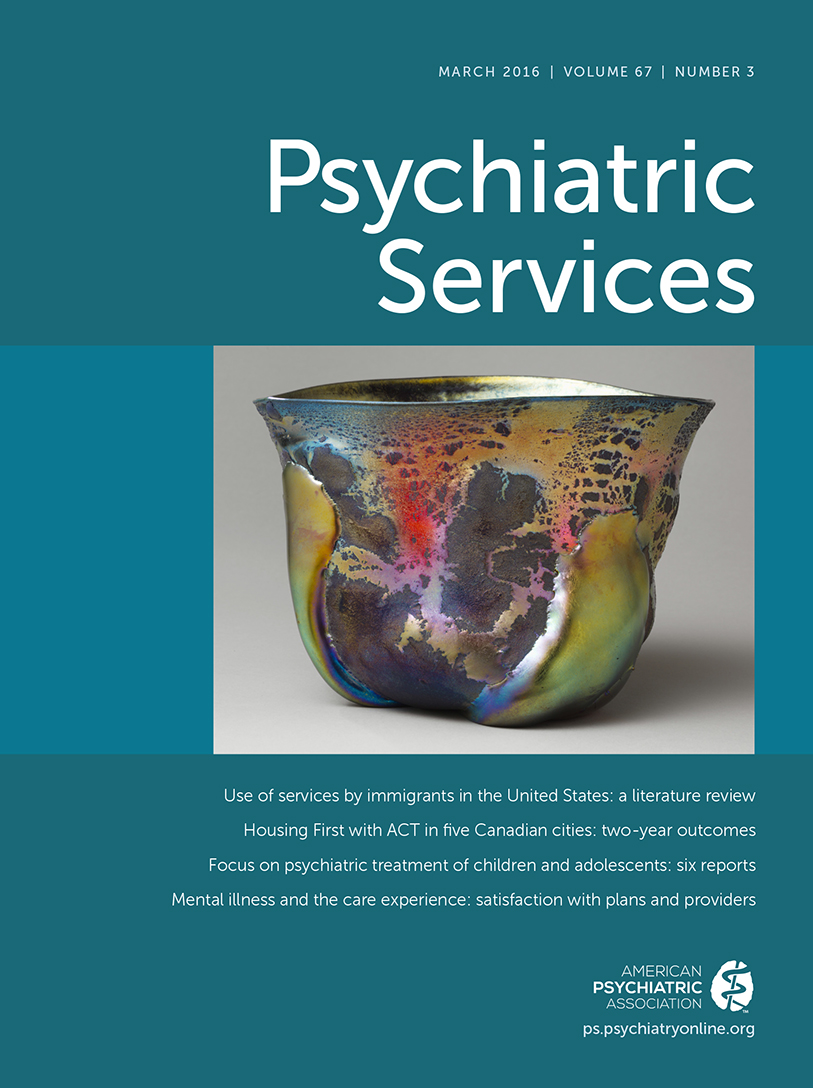Because recommendations for the treatment of depression are based in part on safety and efficacy studies conducted with adults, clinical practice guidelines for the treatment of depression in youth suggest that treatment modalities should be conservative (
3). The effects of psychotropic agents on brain development have not been adequately delineated for humans (
4,
5), and the therapeutic effects of antidepressants vary significantly across age groups (
6). Although untreated depression has substantial long-term consequences, unsafe and ineffective depression treatment also can have adverse outcomes. Therefore, clinical practice guidelines are promulgated for the best benefit-to-risk ratio for youths with depression.
In light of these factors, we sought to investigate the patterns of combination treatment (psychotherapy plus medication), psychotherapy, and antidepressant and antipsychotic treatment across provider specialty, insurance type, regional location, disease complexity and severity, and individual characteristics among privately insured youths with a depression diagnosis. The aim of the study was to determine the extent to which depression treatment conforms to the extant evidence base and to identify factors contributing to observed variations in treatment modalities.
Results
Table 3 reports the prevalence and the unweighted univariate predictors of type of treatment. Nearly a quarter (24.8%) of all depressed youths received medication monotherapy. Of those, 23.5% received first-line medication (fluoxetine), 50.6% received second-line medications (other SSRIs), 9.2% received newer antidepressants (SNRIs, NDRIs, and NaSSAs), and 15.6% received second-generation antipsychotics. Combining all SSRIs (first and second line) accounted for 74.1% of medication monotherapy treatment. Together, non–evidence-based choices (SNRIs, NDRIs, NaSSAs, and second-generation antipsychotics) accounted for 24.8% of medication monotherapy treatment. About 1% of the medication monotherapy sample reported use of tricyclic antidepressants and monoamine oxidase inhibitors (data not shown). Of all youths with depression, 33.6% received psychotherapy alone and 2.7% received combination treatment (fluoxetine plus psychotherapy).
For the unweighted univariate analysis, six characteristics were assessed (provider specialty, private insurance, age group, gender, region, and psychiatric comorbidities). Overall, compared with mental health specialists, primary care providers reported an increased likelihood of choosing fluoxetine alone (p<.001) but were less likely to choose combination treatment, psychotherapy alone, and second-generation antipsychotics (p<.001 for each category). For insurance type, psychotherapy alone was less likely to be used in fee-for-service care compared with HMO care (p<.001). On the other hand, newer antidepressant treatment (p<.001), second-generation antipsychotics (p<.001) and fluoxetine alone (p<.001) were more frequently used under fee-for-service arrangements, compared with HMOs.
Table 4 reports the independent predictors from the multivariable logistic regression. Overall, provider specialty was the most consistent factor predicting treatment of depressed youths. After analyses controlled for demographic characteristics, comorbidities, and illness severity, mental health specialists compared with primary care providers were more likely to choose combination treatment (odds ratio [OR]=8.61), newer antidepressants (OR=1.44), second-generation antipsychotics (OR=2.24), and psychotherapy alone (OR=5.90). First-line treatment was not used differently across specialties.
Compared with HMOs, the odds that PPOs and POSs would use newer antidepressant options were significantly higher (OR=1.44 and OR=1.65, respectively), whereas second-generation antipsychotics were more likely to be used under fee-for-service coverage (OR=1.81). In addition, PPOs were more likely to use fluoxetine alone (OR=1.23) and less likely to use psychotherapy alone (OR=.92). Combination treatment and second-line antidepressant treatment were similarly used across all plan types.
Medication-only and combination regimens were less likely to be used with children compared with adolescents (except for first-line antidepressant medication and second-generation antipsychotics), whereas psychotherapy alone was more likely to be used with children (OR=1.61) than with adolescents. The odds of receiving second-line (OR=.66) and newer antidepressants (OR=.21) were lower for children compared with older adolescents, and males were more likely than females to receive newer antidepressants (OR=1.23) and second-generation antipsychotics (OR=1.54). For regional differences, youths in the Northeast were more likely than youths in the West and South to receive combination treatment, whereas psychotherapy alone was more likely to be used in the West (OR=1.22) than in the Northeast.
Considering illness severity, we found that compared with youths with major depressive disorder, youths with dysthymia were less likely to receive combination treatment (OR=.50), fluoxetine alone (OR=.81), non–evidence-based medication (OR=.83), or psychotherapy alone (OR=.65).
Discussion
The results from this study have important implications for policy makers, physicians, and patients. Nationally, two-fifths of privately insured youths with depression did not receive any depression-specific treatment, and less than 3% received combination treatment. Of youths treated with medication, one-quarter received medications with little to no empirical support, and an additional one-half received medications with uncertain benefits. As such, provider practice for the treatment of depression among privately insured youths does not appear to be in alignment with the current evidence base.
Our findings corroborate previously published studies, signaling low utilization rates of combination treatment (
16). This finding reflects the well-documented difficulties associated with the delivery of psychotherapy in primary care settings (
24). Provider specialty has been recognized in this study as well as in previous research as a key determinant of treatment selection for younger populations (
25). Current health care delivery migration to primary care settings in the United States (
26) and the escalating shortages of mental health specialists all around the country (
27), especially for pediatric patients, require primary care providers to treat patients that historically were managed by mental health specialists. However, primary care providers are typically overburdened with additional demands to provide mental health care with fewer resources, fewer support staff, additional budget constraints, and limited training compared with specialists’ circumstances (
28,
29). The Medical Outcomes Study reported that patients seen by psychiatrists had better functional outcomes (
30), and Callahan and colleagues (
31) found that less than half of primary care providers prescribed a treatment for their patients with depression, even though the clinicians had proper diagnostic scales and treatment algorithms. Furthermore, medication alone for patients with depression is not always effective (especially at follow-up) (
32), and current reimbursement incentives for primary care providers to offer psychotherapy as an alternative may not be worth the time and intensive labor that psychotherapy requires (
30).
Insurance coverage was significantly associated with four out of six treatment options, suggesting an association between less restrictive private insurance arrangements with higher rates of nonrecommended medication options. Our data suggest that prescription of non–evidence-based antidepressants and second-generation antipsychotics was more prevalent in fee-for-service and PPO insurance arrangements, the latter being the more flexible managed care option in terms of specialists’ availability, noncapitated payment arrangements, and no prior approval needed for prescribing specific medications. Compared with more flexible insurance arrangements, managed care’s use of formularies may predispose providers to choose recommended treatments more often. For example, DeBar and colleagues (
33) reported that compared with adolescents covered by PPOs, adolescent members of HMOs were more likely to receive treatment via treatment-concordant protocols and prescription formularies.
In terms of age differences, second-line antidepressants were more likely used to treat adolescents compared with children; this finding may derive from providers’ awareness of FDA approval of escitalopram to treat major depressive disorder beginning at age 12. In general, the age-difference findings reflect a more conservative approach to the treatment of depression for younger compared with older youths.
Effects of illness complexity on prescribing practices indicated an increased likelihood of second-generation antipsychotic prescription for youths with depression plus either PTSD or suicidal ideation, even though second-generation antipsychotics lack empirical support for these indications. Although much less research has focused on treatments for the milder forms of depression (including unspecified depression and dysthymia), current guidelines (
34,
35) suggest that treatment of mild depression should begin with psychotherapy. Nonetheless, the vast majority of youths in this study with a diagnosis of dysthymia received monotherapy (one medication).
Several limitations of this study should be noted. First, we used claims data and may have underidentified patients with depression by excluding those who had an outpatient visit in which a depression diagnosis was not recorded. Second, not all possible comorbid diagnoses were assessed. It is possible that less frequent comorbid conditions, such as disruptive behavior disorders, have an impact on choice of medication, including second-generation antipsychotics. However, their low frequency in the data did not allow separate analysis. Third, even though we tried to identify a depression-free period by excluding those with a prior medication or depression diagnosis before the index date, we recognize that a fraction of our sample may not represent first visits because some may have received treatment prior to our designated clean period. In addition, our definition of combination therapy as the most desirable treatment choice is potentially more applicable to youths with depression nonresistant to SSRIs. Randomized clinical trials are needed to guide future clinical algorithms for youths with other types of resistant depression (such as psychotherapy resistance and SNRI resistance). Finally, primary care providers may be more willing than mental health professionals to use adjustment disorder diagnosis rather than depressive diagnosis for reimbursement purposes. Hence, we may be underestimating the frequency of youths being treated for depression in primary care providers’ settings.
Mental health treatment recommendations and primary care providers’ busy schedules seem to move in opposite directions. Even though recent meta-analytic evidence positions psychotherapy as equal to or possibly greater in effectiveness than antidepressant medication for the treatment of depression of youths (
36), less than 10% of primary care providers in the private sector delivered psychotherapy in 2009. [A table provided in the
online supplement to this article provides further detail.] The collaborative care model for the treatment of depression, shown in over 70 randomized trials to be efficacious in primary care settings for the treatment of depressed adults (
37), now has empirical support for enhancing access to evidence-based treatments (including psychotherapy) and improving clinical outcomes for depressed youths (
38,
39). The collaborative model incorporates (alongside medication management as indicated) evidence-based psychotherapy delivered by colocated mental health clinicians (predominantly master’s level), as well as care management to facilitate patient engagement, treatment adherence, and referral to specialty care if needed (
38,
39). However, the implementation of psychotherapy in primary care settings remains contingent on proper training. For example, cognitive-behavioral therapy (CBT) has been taught in experiential instruction and residential programs and has been effective in increasing providers’ ability to use CBT as a treatment after one year of training (
40). However, for primary care providers, a one-year training program is likely to be too much of a time commitment, and shorter CBT training alternatives should be sought. A 2010 study developed a formalized, multimodal, brief psychotherapy training approach for mental health practitioners in primary care. The workshop lasted 1.5 days and significantly improved both knowledge and self-reported abilities, and the effect was maintained at three-month follow-up (
40).
The use of mental treatment networks (internet-based) may be another feasible approach. For example, for persons between the ages of 14 and 21, the CATCH-IT initiative (Competent Adulthood Transition with Cognitive-Behavioral and Interpersonal Training) is a low-cost preventive intervention that is fairly easy to disseminate in primary care settings and offers resources on building competencies to reduce current and future depressive symptoms (
41). Such modalities may be particularly effective for rural or socioeconomically marginalized clinics.

